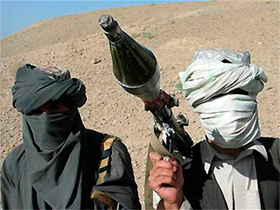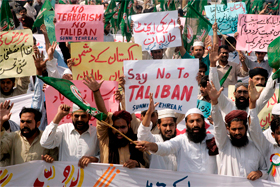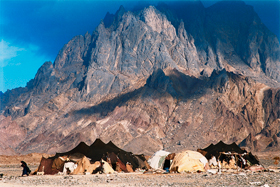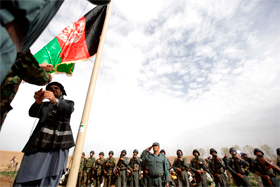The press has received information that the Iranian authorities and the Afghan movement Taliban intend to enter into a tactical alliance against the common enemy – the United States. What can be this cooperation? Are both sides interested in it? Can this alliance of two U.S. adversaries alter the balance of power in the region?
It should be understood that a decision to enter into an alliance with the Taliban would be a highly unusual turn of events in the regional politics of Iran, which is a Shiite state and has traditionally distanced itself from contact with Afghan Sunni radicals. Even during the years of the struggle against the Soviet military presence, Tehran did not resort to direct support of the so-called “Peshawar Seven”, and rather built its own contacts with the Afghan Shiite commanders.
However, the situation has changed. The United States is turning Afghanistan into its military foothold in the region. U.S. military bases will be retained in the country also after the withdrawal of international forces in 2014. In the event of a war with Iran, the U.S. Air Force, stationed in Afghanistan, can be used to strike Iranian industrial and military facilities, while guerrilla units may be deployed or launched through the Iranian-Afghan border.
In these circumstances, Iran is vitally interested in weakening the Americans in Afghanistan, as well as in the resources that could be used for guerrilla warfare against them in the Afghan territory.
Alliance with Iran for the Taliban
Today, the Afghan Taliban are experiencing difficult times. Starting from 2009 international forces have greatly intensified combat operations against armed opposition. The number of land-based operations aimed at capturing and destroying militant leaders has increased, there are ongoing systematic activities on clearing out Taliban activists from south-western provinces, responsibility for law and order in the country is being transferred to Afghan security forces.
Over the last three years, tens of thousands of armed opposition activists have been killed and arrested during fighting, and many prominent field commanders have been captured. Extremists have been pushed out of control over several districts in Herat, Helmand and Kandahar. An important problem is the drop in Taliban’s popularity among the Afghans who are weary of endless wars. Moreover, the increased incidence of civilian casualties caused by roadside bombs planted by the Taliban further damages the image and popularity of the extremists.
All this makes the Taliban search for new resources to support its armed struggle. Historically, the movement is guided by help from Pakistan, whose intelligence services, in fact, created the Taliban in the 1990s. Pakistani security services are still helping insurgents with money and weapons, using them as a tool to influence the Afghanistan policy.
However, Pakistan is presently in a difficult international situation, and being under pressure from the U.S., is forced to cut its support to the militants. In the Pakistani elite, there is apparently disagreement as to whether to continue to support the Taliban or to abandon this method of influence on regional policy and to improve relations with the United States.
Inside the Taliban, there is a growing trend towards greater independence: in recent years, Taliban’s leadership was under the total control of Pakistan, which could not but arouse indignation among many field commanders. One of Taliban’s leaders Mullah Baradar already attempted to connect with other regional powers. However, Pakistan suppressed this attempt, by arresting him and some of his supporters in 2010. A similar major cleaning in Taliban’s leadership took place in spring 2012, which could be the result of new attempts to enter into separate agreements with other countries in the region.
Let us emphasize that the dependence of Taliban’s policy on demands of Pakistani allies now greatly narrows the space for militants to maneuver. They cannot seek compromise with Kabul and Washington that would serve their own interests, but are forced to follow in the footsteps of Pakistani politics, in fact, contributing to solving Islamabad’s geopolitical problems.
Theoretically, entering into a tactical alliance with Iran against the United States would be beneficial to the Afghan Taliban. The movement would receive a new source of finance and weapons, and Quetta (the informal capital of the Taliban) would be freer to engage in dialogue with Pakistan.
However, it is unclear to what extent such an alliance is useful to Iran itself. Yes, in case of war with the United States, the Taliban could become an effective tool for Tehran. Nevertheless, a military solution to the conflict for now remains only a probability. Washington is aware that Iran is a much more formidable opponent than Iraq or Libya, and war can be an ordeal for the United States during the crisis.
If a war does not take place, an alliance with the Taliban could be a “standing stone” of Iranian policy. Cooperation with terrorists could hit the country’s reputation not only in the West, but also in post-Soviet states and China, which consider the Taliban and their radical allies as a potential threat. Besides, extremists in the Iranian border region could become a threat to the regime itself.
Is there an alliance?
The truthfulness of recent media reports about an alliance between the Iranians and the Taliban remains very doubtful. This information comes from some “sources” in the U.S. government agencies and may be banal propaganda aimed at discrediting official Tehran.
Rumors about Iran’s cooperation with other foreign militants appear regularly but typically remain unconfirmed. Specifically, documents published by WikiLeaks a few years ago on the situation in Afghanistan reported that North Korea was supplying arms to Afghan insurgents. These undercover reports did not hold water and could be treated as ordinary rumor. However, if desired, they could also be used to discredit an unwanted regime.
Is this scenario not being played today with Iran? After all, unlike North Korea, Iran really has a common border with Afghanistan and obvious political interests in the regional “big game”.
To date, there is no verified information indicating that the Taliban and Tehran are coming closer. Some of the facts being given raise serious doubts. For example, the media report that Iran allegedly allowed Afghan extremists to set up an office in the city of Zahedan.
First of all, it should be mentioned that in fact “authorized representatives” of the Taliban do exist in most of the states interested in the regional political process. Usually, they are Afghan emigrants who have tribal or political ties with Taliban leaders. As a rule, they are not direct supporters of terrorists and do not reveal their status too broadly, but rather try to persuade the local political elite to cooperate with the Taliban, and if necessary, they act as intermediaries in negotiations. Such “embassies” of the Taliban – informal but well-known to experts and intelligence agencies – exist even in the post-Soviet space.
As for the city of Zahedan, it is well known that this is a region densely populated by Iranian Sunnis who had ties with the Taliban and Al Qaeda back in the 1990s. Later on, the name “Zahedan” appeared in European courts during trials of Islamic terrorists (which, specifically, referred to a major terrorist network operating there).
It is difficult to say whether the Iranian authorities are doing everything possible to eliminate the radical underground in Sunni areas. However, the presence of an infrastructure of militants in the areas is not a new fact, and cannot serve as an indicator of certain political changes.
The Pashtun alternative
The possibility of an alliance between any particular regional powers and the Taliban is now in serious doubt. Islamic extremists have done too much in the past to arouse mistrust and hostility among most states that rightly view the Taliban as a potential threat. In addition, the Taliban’s closeness with Islamabad is well known, and taking control over them can be a daunting task.
However, many countries, including Iran, can search for a political counterweight to U.S. influence in the region. The presence of long-term U.S. military bases in Afghanistan is not in the interest of either Iran, or China, or several other Eurasian states. In order to counter the United States, interested political circles may not only search for contacts with political opposition parties in Kabul, but also create an armed front against U.S. influence in the region in case of a fast war.
The Taliban are not the only ones who can play this role. The crisis being experienced by the Taliban has led to the emergence and strengthening of other armed groups such as the National Uprising Movement in the province of Ghazni. Later, this practice was taken over by other regions. The “rebels” position themselves as anti-Taliban paramilitary groups, but are not friendly to international forces in Afghanistan, which is not surprising, given their unpopularity in the society.
We can assume that any regional player interested in finding armed partners that are disloyal to the U.S. will establish contacts with these people. Besides, we should not forget about the existence of the Islamic Party of Afghanistan (led by Gulbuddin Hekmatyar), which is part of the armed opposition, but is at loggerheads with the Taliban and is looking for ways to integrate into the regional political process, including behind the back of Pakistan. It is possible that these are the forces, which Tehran is seeking contacts with already now.
Thus, an alliance between Iran and the Afghan Taliban is unlikely under the present circumstances. However, it can be expected that Iran, and possibly other regional powers, will seek contacts with Afghan non-governmental armed groups, including anti-Taliban ones.
Despite the coming withdrawal of international troops from Afghanistan, a sharp political confrontation in the country remains. It will gradually drag in new Afghan political forces and new states.









